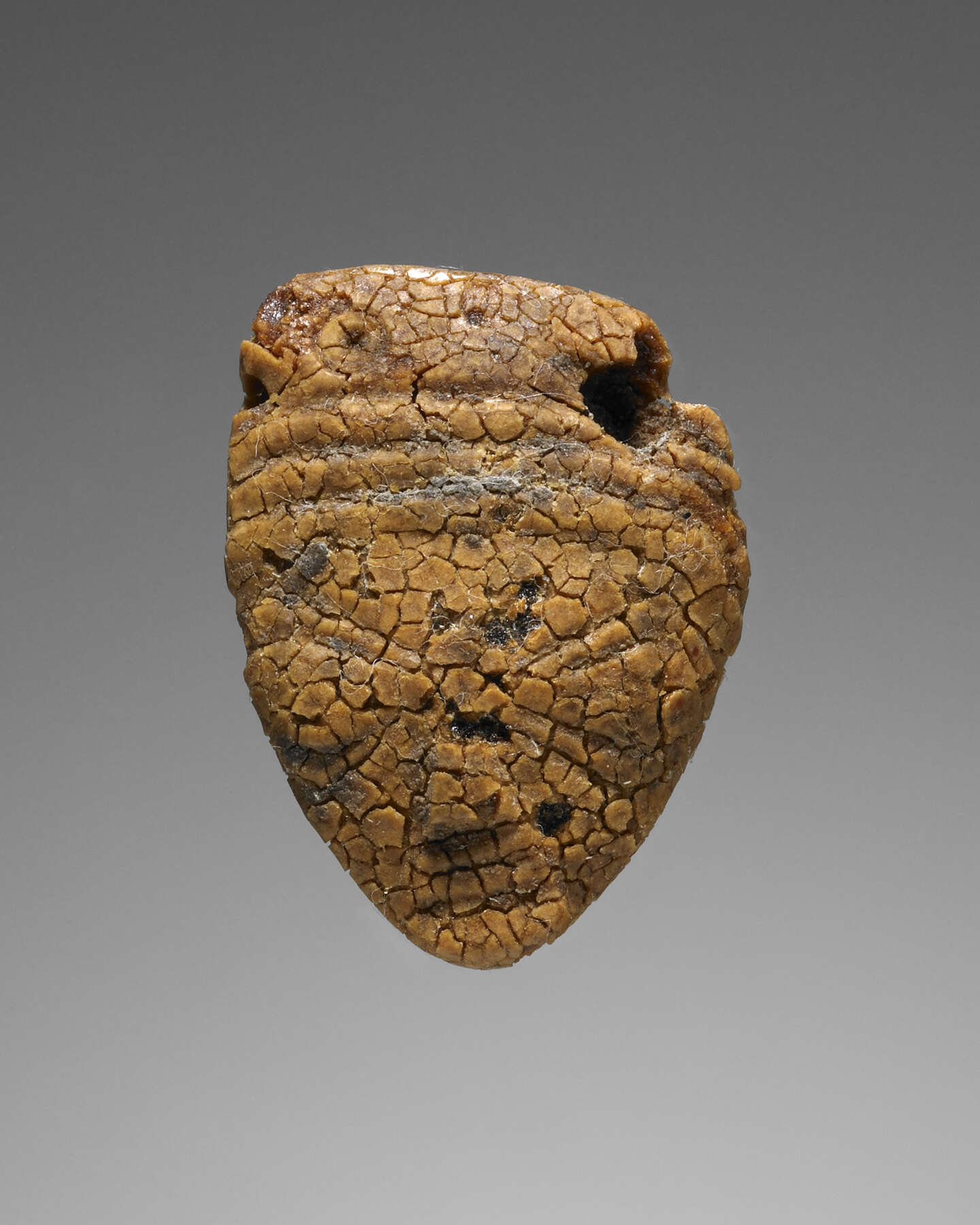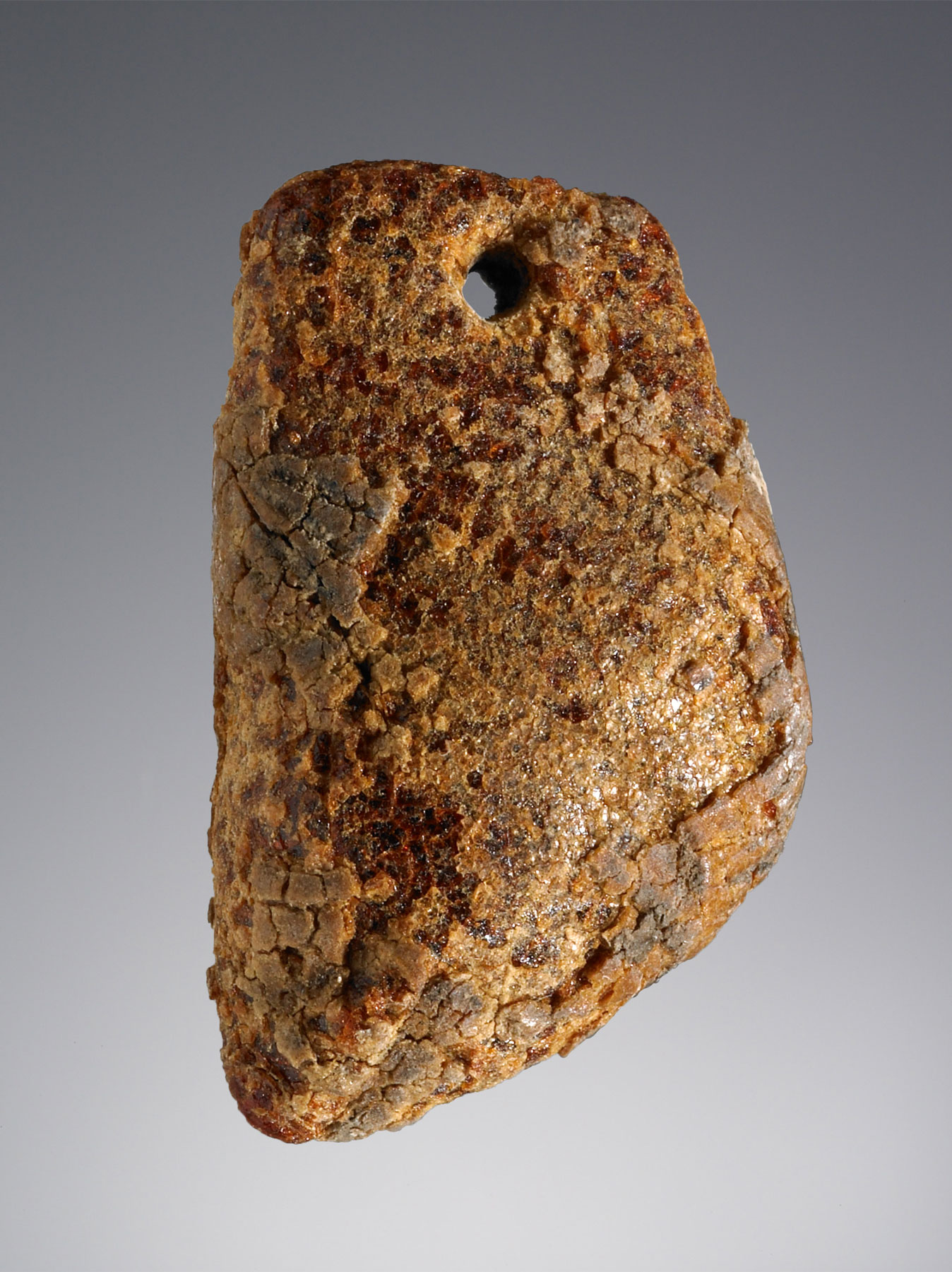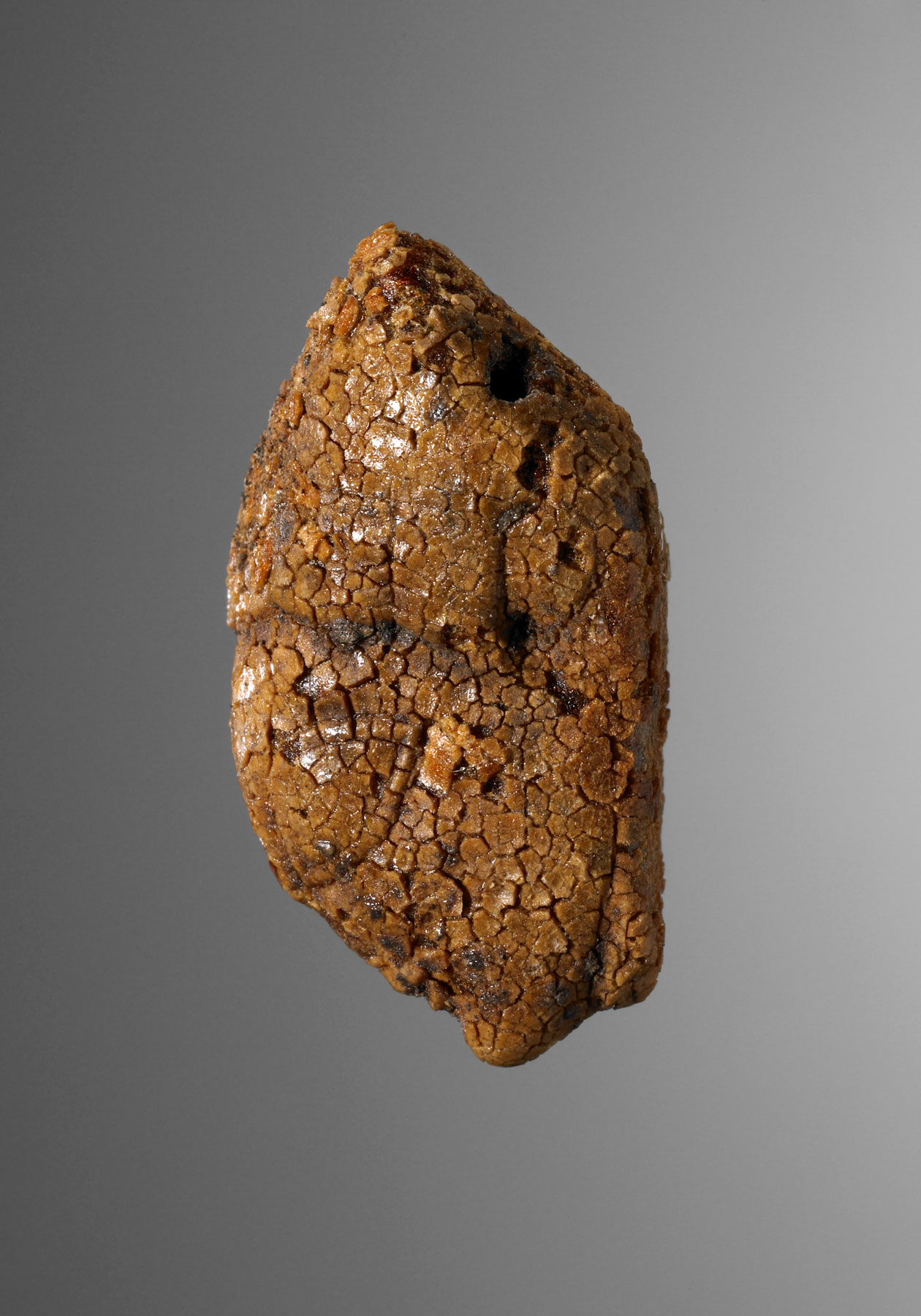21. Pendant: Female Head
| Accession Number | 83.AO.202.12 |
| Culture | Italic or Campanian |
| Date | 500–480 B.C. |
| Dimensions | Height: 30 mm; width: 26 mm; depth: 4 mm; Weight: 2.4 g |
| Subjects | Magic |
Provenance
–1983, Antike Kunst Palladion (Basel, Switzerland); 1983, Vasek Polak, 1914–97 (Hermosa Beach, CA), donated to the J. Paul Getty Museum, 1983.
Condition
The pendant is intact but in poor condition, with a friable, flaking surface. The surface has an overall crack network. A large modern chip is on the left side of the head, and there are many other, smaller modern losses over the entire surface: these reveal the dark red-brown translucent amber beneath. In ambient light, the pendant is opaque and light yellow-tan; in transmitted light, it is dark red and translucent. There are no visible inclusions.
Description
This head is worked from a small, flattish piece of amber. There is no indication of a neck. The reverse is uncorked and flat, and the obverse is slightly more rounded and carved. The face covers half of the pendant, while the other half is devoted to the hair and headdress. The face is widest at the eyes, narrower at the top of the head, and tapered at the chin. The brow is flat and smooth. The large, diamond-shaped eyes wrap around the head, extending from the front plane of the face to the sides of the head. The eyeballs themselves bulge slightly. Both top and bottom rims, indicated by narrow fillets, are angular at the midsection. The eyelid fillets taper in slightly at both of the canthi; they meet at the outer corners but not at the inner ones. The apexes of the upper eyelids nearly meet the lowest horizontal section of the headdress.
The flat, triangle-shaped nose is set off from the cheeks by a long groove that continues to the jawline, incorporating the nasolabial and mouth angle furrows. The mouth is almost straight, with a groove separating the barlike lips. The mentolabial sulcus is also grooved. The small chin projects forward to the level of the lips. Above the brow is a bandlike section of the headdress, composed of three rounded horizontal sections separated by grooved lines. Above the horizontal sections is a tapered, plain section of the headdress that is squared off on top.
There is a stopped bore (1 mm in diameter) at the left side of the head, which still contains its plug. A perforation extends laterally across the head at the headdress. When suspended, the head would have tilted forward, the chin back.
Discussion
This head and (cat. no. 22) have many features in common with (cat. no. 18), (cat. no. 19), and (cat. no. 20). (For a discussion of the common features of the group, see .) This pendant and depict the frontal face rather than the complete head. They are both much flatter and more schematic in conception than and seem to represent an older female than the other three. Most importantly, the headdress worn by 83.AO.202.12 and is distinctly different: it is characterized by horizontal bands on its lower edge (83.AO.202.12 has three bands; has four). The headdress of 83.AO.202.12 sits directly on the brow, with no hair showing. The headdress of sits farther back on the head, behind the straight bangs.
The headdress of 83.AO.202.12 and is a variant of the commonly represented head wraps of amber head-pendants. A striking comparison is an Etruscan terracotta votive figure in Kansas City. She wears a comparable head covering, about which Stephen Smithers noted that the three bands incised into the lower third of her cylindrical polos probably represent the winding of a cloth headdress.1 has straight bangs but no hair showing in back, 83.AO.202.12 has no hair showing at all, and the Kansas City terracotta head has hair showing in front: it is parted in the middle at the brow, sweeps to each side in waves, and is short in back.
The almost insectlike eyes of 83.AO.202.12 and (and of the amber head-pendants cited as comparisons above) are similar to those of bronze korai in Emeline Richardson’s Late Archaic Series C, Group 3A (“Perugians”), such as those in Florence (Museo Archeologico Nazionale 261) and Leiden (Rijksmuseum van Oudheden C.06).2 These bronzes are sophisticated in design and mannered in details, and some have old-fashioned features. Although Richardson does not single out for mention the thickly outlined, wide-open eyes which wrap around the face from the front to the side planes, this manner of representing the eyes must have recalled to its viewers the most ancient of hieratic female images to be found in Italy. So, too, must be the case with the amber head-pendants with huge and staring eyes.
83.AO.202.12 and gain from a comparison with four other groups of amber heads. All have features stretched and skewed, all are asymmetrical, and all would have hung crookedly. All are related, even if the workmanship of 83.AO.202.12 and is more precise. The Getty pieces show how more was accomplished with a fine graving tool.
When the Getty faces are compared to the small, late-sixth-century B.C. faces from Sabine Eretum,3 the commonalties in sculptural approach are apparent: they are all small, flat, and schematic and represent a severe, mature figure. The morphological differences between the Getty faces and those from Eretum are less marked than those between the Getty faces and a pair from a larger group of amber pendants from the earlier-discussed tomb at Roscigno–Monte Pruno,4 perhaps to be dated to the early fifth century. While 83.AO.202.12 and are closer to the Eretum and Roscigno–Monte Pruno sets, they also have features in common with two grave groups of amber head-pendants from female tombs of the first half of the fourth century. The examples are from Tombs 2 and 3 at Melfi, Cappucini.5 The three amber head-pendants of Tomb 2 were found with other figured amber pendants—a strange siren, a schematic “Achelous,” and three faces.
How might this continuity be explained? These rather ugly objects demand answers to this, one of the most compelling questions concerning the working of amber in pre-Roman Italy. Certainly, the makers of the head-pendants are part of the explanation. Another part lies in the origin of or prototype(s) behind the type, which must date to the earlier sixth century, if not before, in Etruria. That all of the heads were perforated to hang crookedly may be evidence of their use and identity. Is this meant to convey that they are reverted, and thus specifically refer to death, guardianship, and other magical workings?
Notes
- , pp. 214–15, compares the votive to a marble kore in Athens (Acropolis Museum Akr. 688) dated circa 480 B.C. ↩
- , pp. 314, 744–46. These same insectlike eyes are seen on a number of amber heads. The earliest is the late-eighth-to-early-seventh-century head from Stephens Tomb 108, Cumae (E. Gabrici, “Cuma,” XII [1913]: col. 609, fig. 220). For two now-lost heads from Cumae, two from Oliveto Citra, one from Canosa, and three from Termoli (Molise), see , p. 210, n. 20. ↩
- For the ambers from Eretum, Colle del Forno, Tomb XIII, see, for example, . ↩
- See cat. no. 17. For a recent discussion of this group, see , p. 203. ↩
- , pp. 61–63, no. 5 (22ab, 23ab). ↩
Bibliography
- Bottini 1990
- Bottini, A. “Le ambre intagliate a figura umana del Museo Archeologico Nazionale di Melfi.” Archeologia: Wrocław Zakład Narodowy im. Ossoli’nskich 41 (1990): 57–66.
- Losi et al. 1993
- Losi, M., B. Raposso, and G. Ruggiero. “The Production of Amber Female Heads in Pre-Roman Italy.” In Amber in Archaeology: Proceedings of the Second International Conference on Amber in Archaeology, Liblice, 1990, edited by C. W. Beck and J. Bouzek, pp. 203–11. Prague, 1993.
- Richardson 1983
- Richardson, E. H. Etruscan Votive Bronzes: Geometric, Orientalizing, Archaic. 2 vols. Mainz am Rhein, 1983.
- Smithers 1988
- Smithers, S. G. “The Typology and Iconography of Etruscan Terracotta Curotrophic Votives: The Heads and Bambini.” Ph.D. diss., University of Iowa, 1988.




